Ten Most Endangered Australian Marsupials
Australian Marsupials - Fighting for their Existence
Pouched Australian Native Animals
Australia has a number of endemic species that are doing it tough at the moment.
Marsupials in particular are having a battle retaining their place in the web of life. Marsupials are animals whose babies are born in an underdeveloped state and who finish their growth in a pouch. The following are regarded as Australia's ten most endangered marsupial species.
1 The bridled nail-tail wallaby is named for the 'bridle' formed by markings on the head and forequarters. A distinct white line runs from the back of the neck to behind the forelimbs. It is an attractive small wallaby with white stripes along the sides of the face and a dorsal black stripe right down the length of the back. The rest of the body is a light tan. The 'nail-tail' comes from the horny 'nail' or spur at the tip of the tail. This is between 3 and 6mm long and is partially concealed by hair. Its purpose is not clear.
Its scientific name is Onychogalea fraenata. It was once common from north of Charters Towers, Queensland, south to north-western Victoria and west to the Great Dividing Range.It is now found in only 5% of its previous range. It was thought to be extinct until a small colony was found in central Queensland near Dingo. It has now been re-introduced to several areas including the Scotia Sanctuary in western NSW. Its main threats are predation by foxes, cats and wild dogs, habitat loss and competition from domestic livestock and rabbits.
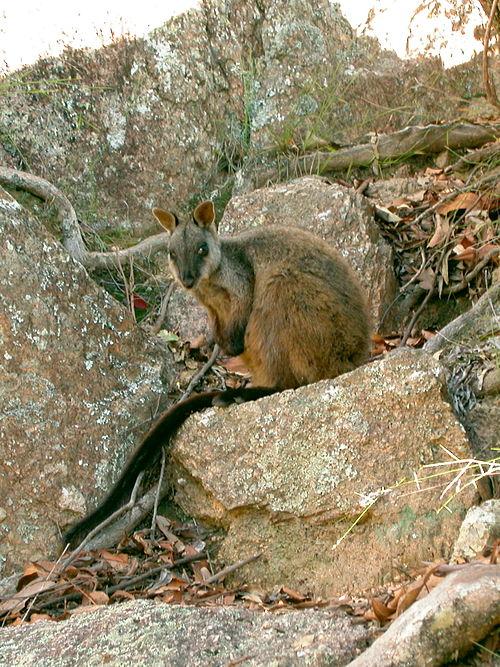
2 The brush-tailed rock wallaby (Petrogale penicillata)(above) is now found only in fragmented pockets of southern Queensland and Victoria. The recent bushfires have all but wiped out the Victorian populations. Threats include predation by foxes, cats and wild dogs, habitat loss and competition from domestic livestock and rabbits. Road kill accounts for a sizeable number where a road bisects its territory in Queensland.
In 2003, a population was discovered on Kawai Island, New Zealand. These were designated for culling as feral animals but 30 were rescued and returned to New South Wales and Victoria.
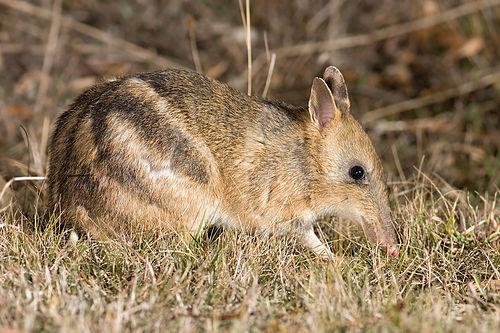
3 The eastern barred bandicoot (Perameles gunnii)(above) is a nocturnal marsupial. Although once common across south-eastern Australia, it exists in reasonable numbers only in Tasmania. Destruction of the animals' grassland habitat has resulted in the decline in numbers, hastened by the introduction of predators such as dogs and cats.
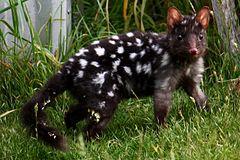
4 The eastern quoll (Dasyurus viverrinus)(above) was once called a native cat because of its size and appearance. However it is smaller than a cat and no relation. It is a small, nocturnal black or brown marsupial. Its coat is marked with small, white spots. The ears are large and it has a pink nose. Quolls are important carnivores (mainly) as they act as scavengers, eating insects and small animals. They will also eat grass and fruit. The quoll is a courageous animal, quite happy to scavenge around feeding Tasmanian devils. Foxes are the main threat to the eastern quoll. They were found throughout the south-eastern parts of mainland Australia but are now confined to Tasmania.
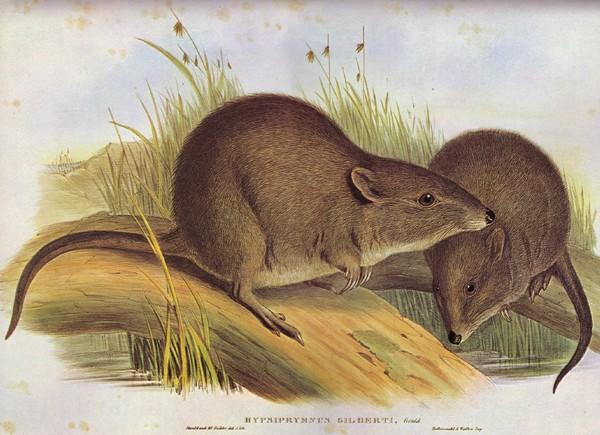
5 Another small marsupial is Gilbert's potoroo (Potorous gilbertii)(above). A decent bushfire or drought could result in the extinction of this little fellow which is found only in a small area of dense scrub on Western Australia's southern coast. It is Australia's rarest mammal with only 30 to 40 remaining. This rat-kangaroo was thought to be extinct until being rediscovered at Two Peoples Bay near Albany. Long-nosed potoroos are being used as foster mothers to maximise survival rates and it is possible a colony will be set up on Bald Island.
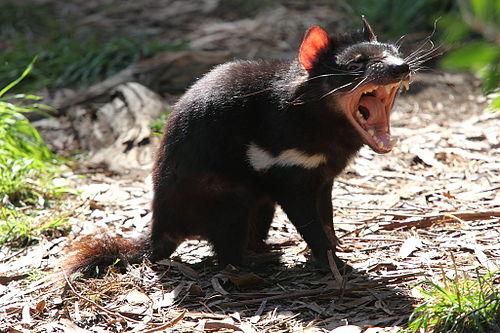
6 The Tasmanian Devil (Sarcophilus harisii)(above) is very distinctive with a very dark coat and a white band across the chest. The male reaches about 90cm in length (this includes the tail) and weighs over 8kg. The female is quite a bit smaller. The Tasmanian devil has a head like a dog with large, pinkish-red ears. They have an exceptionally acute sense of smell and can pick the scent of carrion from many kilometres away. This animal uses as log, cave or disused burrow as a den and emerges at night to scavenge and forage. While fierce by nature, the main diet is carrion. The jaws are powerful enough to break up very large bones. In recent years, the Tasmanian devil has been beset by devil facial tumour disease (DFTD), an aggressive, transmissible cancer which has ravaged wild populations, sometimes with a 100% mortality rate.
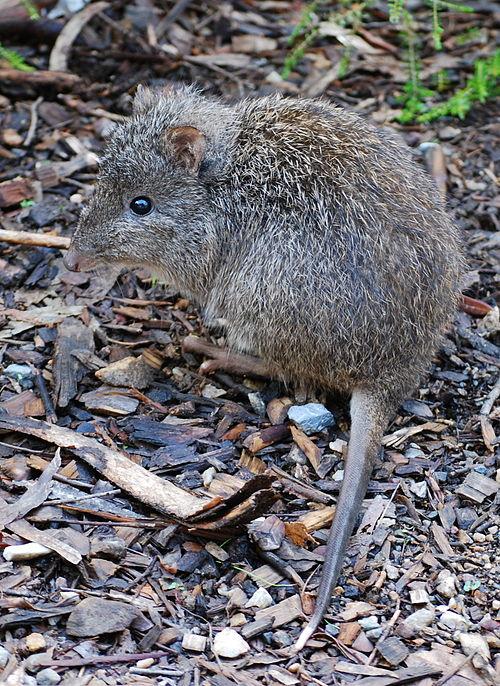
7 The long-nosed potoroo (Potorous tridactylus tridactylus)(above) is one of the smallest and most ancient of the kangaroo family. The south-east mainland form is under severe threat from feral predators and habitat destruction. The potoroo lives in dense scrub and the understorey of grassy woodlands. It plays an important role in the ecology of soils and grasses in particular.
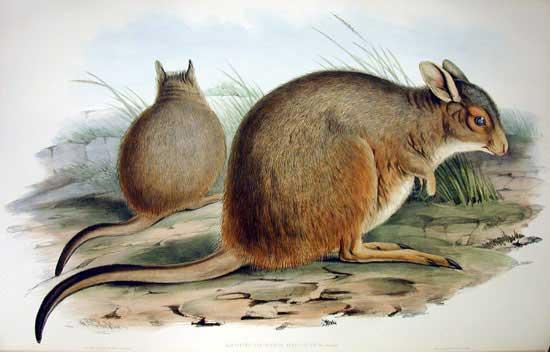
8 The central mainland form of the mala or rufous hare wallaby (Lagorchestes hirsutus)(above) is believed to be in the top three most critically endangered animals. It is a somewhat shaggy, reddish wallaby which now considered extinct in the wild. The remaining representatives live in protected areas in wildlife parks and zoos.
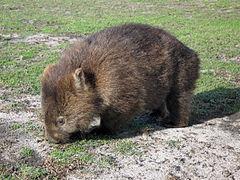
9 The northern hairy-nosed wombat (Lasiorhinus krefftii)(above) is the most endangered of the three wombat species. There is only one group of about 113 animals in Epping Forest National Park in eastern Queensland. Clearing has destroyed much of its habitat, sheep and cattle compete for food and dingoes are partial to a wombat when they're hungry. At the park, a dingo-proof fence has been erected. Supplementary feed and water stations help offset the effects of local droughts which impact on older animals and lactating mothers.
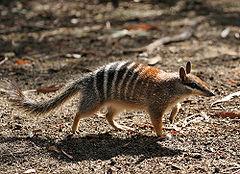
10 The numbat or banded anteater (above) was once found right across southern Australia in all habitats including desert regions. Its scientific name is Myrmecobius fasciatus. It is the mammal emblem of Western Australia. The introduction of the fox had a devastating impact on numbats in particular and Australian native small mammals in general. It is estimated that there were less than 200 numbats left in 1982. The numbat is the only marsupial that is insectivorous. It is small, about 24cm long with black and gold stripes and a flashy, bushy tail. It is diurnal and eats only termites. The tongue is long and sticky but the claws are not really strong enough to break open termite mounds. However the numbat has a strong sense of smell and snuffles along until it finds the underground track that termites use to go to and fro from their nest to the feeding site. The numbat then digs into the shallow tunnel to feed.
These creatures are unique to Australia and Tasmania. What a dreadful calamity it would be if they were to become extinct.
- Beautifully Unique Mammals With Stripes
The two most popular striped mammals are the Tigers and Zebras. Aside from these two striped animals, can you name more stripes mammals? Western Bongo Image Source Western Bongo or Tragelaphus eurycerus eurycerus is unique mammal with white-yellow...
- Are Koalas Endangered?
Credit: Erik Veland via Wikimedia Commons Koala is the common name for the arboreal marsupial which resembles the appearance of a teddy bear with very quiet habits, similar to those of a sloth. It is a really beautiful and friendly animal. But are koalas...
- Wild Animals Of The World - The Dingo
Australia's Wild DogsThe WarrigalThe Australian dingo is unique to that continent. It is sometimes called the warrigal. Although thought to have originally arrived from south-east Asia thousands of years ago, its isolation from other canines and the...
- One Of A Kind - The African Painted Dog
The African Painted Dog - An Example of a Monotypic SpeciesWhere Do African Wild Dogs Live?African hunting dog factsThe African painted dog is the only living species of the genus Lycaon although there are five recognised subspecies. It is therefore a...
- One Of A Kind - The Common Wombat
The Common Wombat - an example of a monotypic speciesThere are three species of wombat but the common wombat (coarse-haired or bare-nosed wombat) is the only one in the genus Vombatus, making it a monotypic species. There are three subspecies the common...
